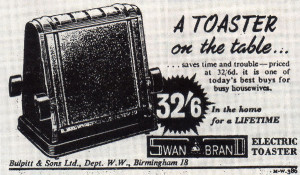
Some of us remember life before sliced bread, eye-level grills and toasters. My grandmother used a toasting fork in front of a coal fire. When I was too young to be trusted with the job I coveted it, but no sooner was I old enough to have the toasting-fork thrust in my hand that I realised the drawbacks were a scorched face and, if my concentration lapsed for a single second, nothing to show for my trouble but charred, smoking bread.
Thank heavens we made it under the grill at home, I thought. That grill was waist-high, and the fact that you had to keep ducking down to see how the toast was getting on didn’t matter a hoot, because the eye-level grill hadn’t been invented.
By the time I grew up it had:
“I’m delirious about our new cooker fitment with the eye-level grill,” went the number We’re Ever so Mouse and Gardens from the 1950s Flanders and Swan show. “At the drop of a hat…that way, without my having to bend down, the hot fat can squirt straight into my eyes” – and the audience rocked with indulgent laughter.
The older generation might have thought them a novelty and an encouragement to be lazy, but the younger generation decided they’d come to stay, and few brides would settle for less.
When my turn came I chose a New World 42, complete with eye-level grill, and the whole cost about £40, which was paid off over three years in quarterly instalments to North Thames Gas Board. With such as treasure I didn’t feel
the need for an electric toaster, but like sliced bread they’d rapidly caught on and willy-nilly I was given one. Mine was drop-sided like the one in the picture and had already been outclassed by the newer, more expensive pop-up toasters.
Drop-sided and I were at loggerheads from the start, mainly because the sliced bread I bought didn’t fit it. If i’d had the skill to cut bread as fine as Ryvita I might have been in with a chance. As it was, my slices always touched the elements and the toast came out with two firm black stripes that divided it into three parts like ancient Gaul. That wasn’t the only problem. Smoke and smells issuing through the ventilation holes in the toaster’s top meant I’d left the bread in too long. Only by repeatedly pulling down the little flaps to see how the toast was coming along and turning it round and going
throught the whole tedious business on the other side could I be assured of success. In a matter of weeks my patience ran out and the toaster went to a young colleague who was coping in a bedsitter with just two gas rings and an electric kettle, he loved it as much as I’d hated it, and returned the compliment with a pink hyacinth in a pot that I found much more to my liking.
Perhaps if I’d been given a pop-up toaster things might have been different. They were all the rage with young parents because on Sunday mornings the kids could make their parents breakfast while they had an extra forty winks. In those days the element was in the middle and you still had to turn the toast round the first time it popped up and brown the other side.
Young people setting up home today can’t imagine life without one, and modern versions will toast up to four slices on both sides at the same time, boasting coolwall sides, thick and thin adjustments and crumb trays.
My only crumb tray is the grill-pan on New World 42. In its long life it has been converted to North Sea Gas and among other things must have produced miles of pikelets, muffins and toast. I felt a bit hurt for it when one of its family featured in Arkwright’s kitchen in Open All Hours, and admittedly mine could be spruced up with a new cover and pan for its eye-level grill. Anyone know where I might find them?
Pamela Howarth








